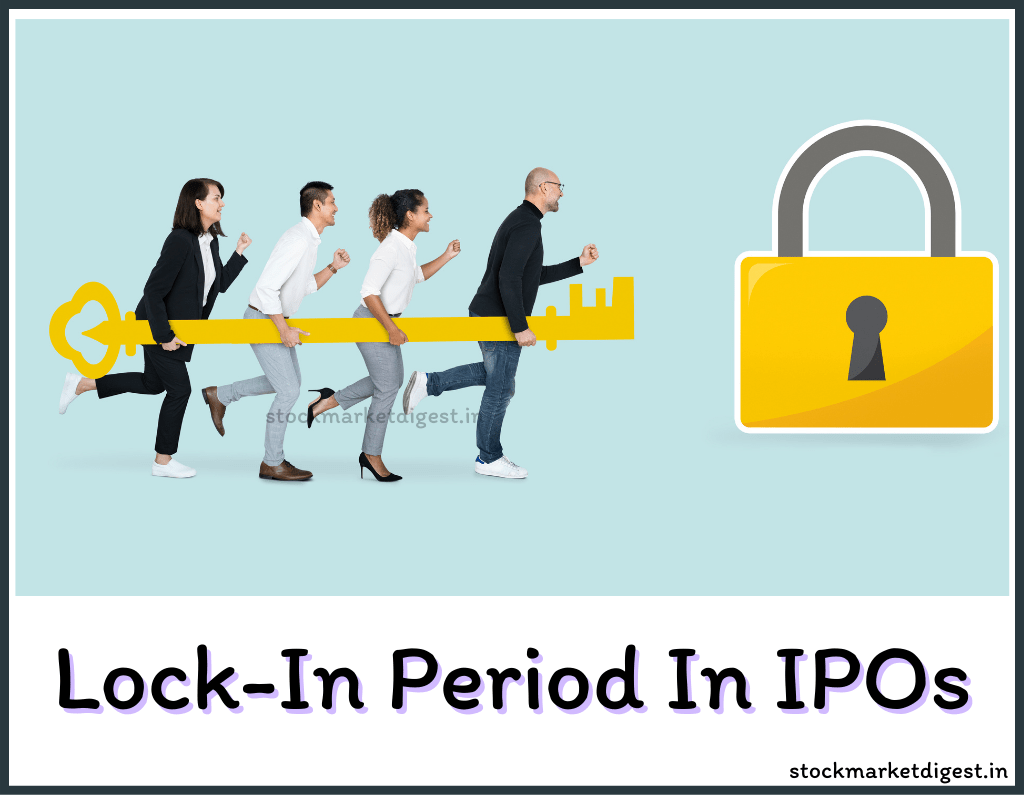Investing in Initial Public Offerings (IPOs) can be an interesting opportunity for both big investors and everyday people to join a company’s transition from private to public.
When companies decide to go public, they sell shares to gather money, usually with the help of investment banks through a process called an IPO.
In this guide, we’ll explore why the lock-in period in IPOs is important and how it affects the way investors behave and the overall market situation.

What is an IPO?
An IPO is the process where a private company transitions into a publicly traded entity by selling shares to the public. This capital infusion supports the company’s expansion and other financial objectives.
Investment banks play a crucial role in setting the IPO price and underwriting the offering, ensuring a stable launch into the public market.
Also Read : Difference between IPO and OFS (Offer For Sale)
Lock-In Period in IPOs: An Overview
The lock-in period is the duration during which IPO investors are restricted from selling their shares. This period, typically spanning from six months to a year, aims to bring stability to a newly listed company’s share price.
It ensures that early investors, including employees and promoters, do not immediately sell their shares post-IPO, encouraging a focus on the company’s long-term growth.
Types of Lock-In Periods According to SEBI Guidelines
SEBI (Securities and Exchange Board of India) provides guidelines on lock-in periods for various categories of IPO investors:
- Promoters: Lock-in reduced to 18 months for up to 20% of post-issue paid-up capital.
- Anchor Investors: 90 days for 50% of allotted shares, followed by an additional 30 days for the remaining 50%.
- Non-Promoters: Lock-in period reduced to 6 months from the initial 1 year.
Purpose of the Lock-In Period
The lock-in period serves a dual purpose. For companies, it offers a stabilization period after going public, preventing massive sell-offs that could adversely impact share prices.
Simultaneously, it instills confidence in long-term investors who are genuinely interested in the company’s growth rather than short-term gains.
Stabilizing Share Prices: By preventing early investors from immediately selling their shares, the lock-in period helps avoid a sudden influx of shares into the market, which could lead to excessive selling pressure. This, in turn, contributes to stabilizing the company’s stock prices during the crucial initial phase post-IPO.
Encouraging Long-Term Investment: The lock-in period promotes a long-term investment outlook among shareholders. Investors who participate in an IPO with a longer commitment horizon are more likely to align with the company’s growth and strategic goals, fostering a sense of partnership between investors and the company.
Building Investor Confidence: For the broader investment community, the lock-in period signals a commitment from early investors to the company’s future success. This commitment builds investor confidence by indicating that major stakeholders are not looking for immediate gains but are willing to support the company’s growth trajectory.
Preventing Post-IPO Volatility: Without the lock-in period, there could be a risk of significant volatility in the stock price as early investors rush to sell their shares. The lock-in period acts as a preventive measure against such volatility, allowing the market to absorb the new shares more gradually.
Supporting Company Stability: Newly listed companies often face challenges in adjusting to public market dynamics. The lock-in period provides a buffer, allowing the company to navigate this transition with a degree of stability before facing the full impact of shareholder trading.
Drawbacks of the Lock-In Period
While the lock-in period provides stability, it can create uncertainty among retail investors. The inability of major investors to sell during this period may give a false impression of demand and affect market sentiments.
Additionally, when the lock-in period concludes, a sudden sell-off by large investors could lead to a sharp decline in stock prices.
Market Misinterpretation: During the lock-in period, the restriction on major investors selling their shares may create a false impression of the stock’s demand in the market. Retail investors might find it challenging to gauge whether major investors lack confidence in the company or are simply abiding by regulatory restrictions.
Post-Lock-In Price Volatility: Once the lock-in period expires, there is a possibility of a sharp decline in the stock price. This could occur if a significant number of investors decide to sell their shares simultaneously to capitalize on post-lock-in price increases. The oversupply of shares may lead to a drop in value.
Bearish Market Sentiment: The end of the lock-in period may trigger a bearish sentiment among potential investors. The perception of major investors exiting their positions can make others hesitant, impacting the stock’s attractiveness.
Requirements for Selling Shares on the First Day of Trading
Normally shares tend to list on the Stock Exchanges based on based on Grey Market Premium and retail investor rush to pocket the listing gain.
However, for other category of investors to sell shares on the first day of trading, they must meet specific requirements, including SEBI registration, a minimum net worth of Rs.100 crore, and adherence to ownership and issue size criteria.
SEBI Registration: Individuals or entities wishing to sell shares on the first day of trading must be registered with the Securities and Exchange Board of India (SEBI). SEBI regulates securities markets in India, and registration ensures compliance with regulatory standards.
Minimum Net Worth: Sellers are typically required to have a minimum net worth of Rs. 100 crore, as per the latest audited balance sheet. This financial requirement demonstrates the seller’s financial stability and capacity to participate in share trading.
Promoter Shareholding: The pre-issue promoter’s shareholding should not be less than 51%. This emphasizes the importance of substantial ownership by the promoters, aligning their interests with the company’s performance.
Minimum Public Offering: A minimum of 25% of the total issue size must be sold to the public. This ensures a reasonable distribution of shares among public investors, promoting fairness in the offering process.
IPO Price Requirements: The IPO price must be at least 20% higher than the floor price. This requirement sets a baseline for the IPO pricing, preventing undervaluation and promoting a fair market value for the shares.
Also Read : What is an IPO Cycle and What are the stages in in?
Conclusion
the lock-in period in an IPO plays a crucial role in maintaining stability, preventing abrupt sell-offs, and instilling confidence among both companies and investors. It is a strategic mechanism designed to navigate the post-IPO scenarios and contribute to the overall success of the newly listed company.
The lock-in period of an IPO presents a combination of advantages and drawbacks that investors should carefully consider. On the positive side, the investment remains secure and insulated from short-term market fluctuations during this period. This stability can be reassuring for investors, especially those looking for a more predictable environment.
However, it is essential to approach all the Upcoming IPO investments with a discerning mindset. While the lock-in period provides a safeguard against immediate market volatility, it’s crucial not to solely rely on this factor. Instead, investors should base their decisions on a thorough evaluation of the company’s fundamentals
FAQs: Lock-In Period in IPOs
Q1. What is the lock-in period in an IPO?
Answer: The lock-in period in an IPO refers to the duration during which early investors, such as promoters and anchor investors, are restricted from selling their shares in the newly listed company.
Q2. How long does the lock-in period typically last?
Answer: The lock-in period for an IPO usually spans from six months to one year, depending on the category of investors. Promoters, anchor investors, and non-promoters may have different lock-in periods.
Q3. Why is there a lock-in period in IPOs?
Answer: The lock-in period is implemented to stabilize the share price of a newly listed company. It prevents early investors from immediately selling, promoting long-term investment and reducing post-IPO volatility.
Q4. What are the different types of lock-in periods according to SEBI guidelines?
Answer: SEBI guidelines categorize lock-in periods for various investors. Promoters typically face an 18-month lock-in for up to 20% of post-issue paid-up capital. Anchor investors have a 90-day lock-in for 50% of allotted shares, followed by an additional 30 days for the remaining 50%.
Q5. Can investors sell their shares before the end of the lock-in period?
Answer: There are exceptions to the lock-in period. If shares are sold or transferred before the end of the period, investors may not be subject to lock-in restrictions.
Q6. What happens at the end of the lock-in period?
Answer: At the end of the lock-in period, investors are free to sell their shares on the open market. However, if the share price has dropped below the IPO price, investors may incur a penalty or loss.
Q7. How does the lock-in period benefit companies and investors?
Answer: The lock-in period benefits companies by providing stability after going public and discouraging mass sell-offs. For investors, it instills confidence in the company’s long-term prospects.
Q8. Are there risks associated with the lock-in period?
Answer: Yes, there are risks, including the potential for a sharp decline in stock prices when the lock-in period concludes. Investors should be aware of market conditions and company performance.
Q9. What are the requirements for selling shares on the first day of trading?
Answer: To sell shares on the first day of trading, investors must be registered with SEBI, have a minimum net worth of Rs.100 crore, and meet ownership and issue size criteria.
Q10. How does the lock-in period contribute to share price stability?
Answer: The lock-in period restricts the immediate sale of shares, preventing a large influx of shares into the market. This restriction helps in stabilizing the share price during the initial post-IPO period.
Check Out Below Articles Related to IPO:
- How to Buy IPO Online in India – Procedure and Eligibility Criteria
- How to Apply for an IPO Through UPI – In 7 Easy Steps
- Difference Between Equity IPO and Debt IPO
- What is Book Building Process in IPO? Fixed Pricing Vs Book Building
- What Is Cut-Off Price in IPOs – Why is it Important?
- Is PAN Card Mandatory for Applying to an IPO?
- What is Market Lot Size and Minimum Order Quantity in IPO?
- What Is the IPO Cycle In Stock Market?
- How the IPO Grading Works In India?
- 11 Common IPO Mistakes and How to Avoid them
- 7 Biggest IPOs of India of All Time
- What is Draft Red Herring Prospectus (DRHP) in IPO?
- What is IPO Lot Size and How It is Calculated?
- 15 Step Guide on How to Analyse an IPO
- What is a Shelf Prospectus, Criteria and How Can it Benefit an Investor?

